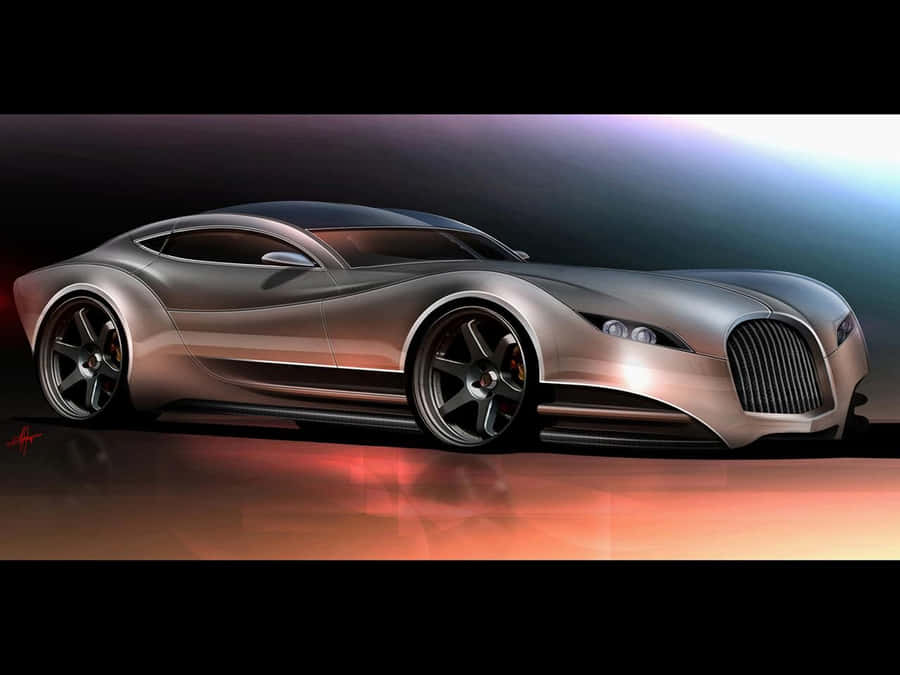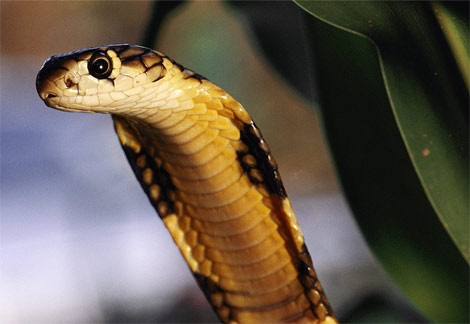The King Cobra is a large and powerful snake, averaging 3.6–4 m (12–13 feet) in length and typically weighing about 6 kg (13.2 lb). A particularly large specimen was kept captive at the London Zoo, and grew to 5.7 m (18.8 ft) before being euthanized upon the outbreak of World War II. Despite their large size, king cobras are fast and agile.
Characteristics
The skin of this snake is either olive-green, tan, or black, and it has faint, pale yellow cross bands down the length of the body. The belly is cream or pale yellow, and the scales are smooth. Juveniles are shiny black with narrow yellow bands (can be mistaken for a banded krait, but readily identified with its expanded hood). The head of a mature snake can be quite massive and bulky in appearance, though like all snakes, they can expand their jaws to swallow large prey items. It has proteroglyph dentition, meaning it has two short, fixed fangs in the front of the mouth which channel venom into the prey like hypodermic needles. The male is larger and thicker than the female. The average lifespan of a king cobra is about 20 years.
 Identification
Identification
The king cobra is the sole member of genus Ophiophagus, while most other cobras are members of the genus Naja. They can be distinguished from other cobras by size and hood marks. King cobras are larger than other cobras, and the stripe on the neck is like the symbol "^" instead of a double or single eye(s) shape that may be seen in most of the other cobras. A foolproof method of identification is if on the head, clearly visible, is the presence of a pair of large scales known as occipitals, at the back of the top of the head. These are behind the usual "nine-plate" arrangement typical of colubrids and elapids, and are unique to the king cobra.
Scalation
Dorsal scales: midbody 15 rows; Ventral scales: Males 235-250, females 239-265; Tail: Subcaudal scales single or paired in each row, 83-96 in males and 77-98 in females.
Habitat
The king cobra is distributed across South Asia, Southeast Asia, and the southern areas of East Asia (southern China) where it is not common. It lives in dense highland forests, preferring areas dotted with lakes and streams. King cobra populations have dropped in some areas of its range because of the destruction of forests. It is listed as an Appendix II Animal within CITES.Behavior
King cobras, like other snakes, receive chemical information ("smell") via their forked tongues, which pick up scent particles and transfer them to a special sensory receptor (Jacobson's organ) located in the roof of its mouth. When the scent of a meal is detected, the snake flicks its tongue to gauge the prey's location (the twin forks of the tongue acting in stereo); it also uses its keen eyesight (king cobras are able to detect moving prey almost 100 m [300 feet] away), intelligence and sensitivity to earth-borne vibration to track its prey. Following envenomation, the king cobra will begin to swallow its struggling prey while its toxins begin the digestion of its victim. King cobras, like all snakes, have flexible jaws. The jaw bones are connected by pliable ligaments, enabling the lower jaw bones to move independently, enabling the King cobra to swallow its prey whole. The expansion of the jaw enables the snake to swallow prey much larger than its head.
King cobras are able to hunt at all times of day, although it is rarely seen at night, leading most herpetologists to classify it as a diurnal species.
[edit] Defense
The king cobra can be highly aggressive if provoked. When threatened, it raises up the anterior portion of its body, extending the neck, showing the fangs and hissing loudly. (Bioacoustic analysis of the "growl" of the king cobra has shown that it differs significantly from other snakes. Generally a typical snake hiss has a broad-frequency span (~3,000 to 13,000 Hz) with a dominant frequency near 7,500 Hz, whereas the "growl" of the king cobra consists of frequencies below 2,500 Hz, with a dominant frequency near 600 Hz.) It can be easily irritated by closely approaching objects or sudden movements. The king cobra attacks rapidly, and the strike distance is about 2 m (7 feet); people can easily misjudge the safe distance. The king cobra may deliver multiple bites in a single attack, or bite and hold on.[11] Although it is a highly dangerous snake, it, just like other snakes, prefers to escape unless it is cornered or provoked.
If a king cobra encounters a natural predator, such as the mongoose, which has some resistance to the neurotoxins, the snake generally tries to flee. If unable to do so, it forms the distinctive cobra hood and emits a hiss, sometimes with feigned closed-mouth strikes. These efforts usually prove to be very effective, especially since it is more dangerous than other mongoose prey, as well as being much too large for the small mammal to kill with ease
 king cobra snake
king cobra snake
 king cobra snake
king cobra snake
 king cobra snake
king cobra snake
 world dangerous king cobra snake
world dangerous king cobra snake
 king cobra snake
king cobra snake
 king cobra snake
king cobra snake
 most dangerous king cobra snake
most dangerous king cobra snake
 king cobra snake
king cobra snake
 king cobra snake
king cobra snake
No comments:
Post a Comment